By Michael Bailey
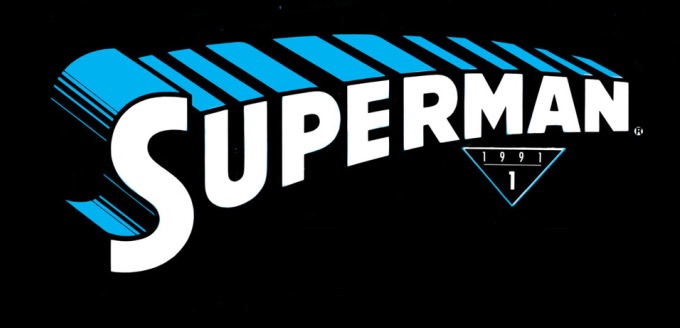
Several online retailers, including Amazon, have a listing for Superman: The Triangle Era Omnibus Vol. 1. It has a release date of September 3, 2024, though that is subject to change, but for the moment it seems like this is actually going to come out.
And to fans of the era, it’s a big deal.
Like a really big deal.
But there may be some of you out there who weren’t around at the time or were around at the time and didn’t read the Superman titles that might be thinking, “What’s the big deal? It’s just an omnibus. DC puts those out all of the time. Also, those comics are like super old. No pun intended.”
And that’s a fair question. The big deal thing. And the DC putting out omnibuses all of the time thing. Not the books being old thing. That’s just kind of mean. I mean, sure, the books being reprinted are were on the stands over three decades ago and a lot of the fan base for the Triangle Era read those books at or around the time they came out but that doesn’t mean we’re old.
Not really.
Okay, maybe a little.
Okay, maybe a lot.
Okay, if you read these books right off the stands in 1990/1991 this is your reminder to take that ibuprofen as soon as you finish reading this because that knee is going to start acting up soon and you want to get ahead of that.
Where was I?
Oh yeah. The omnibus.
The announcement of the omnibus’ release got me thinking that it might be fun and maybe even informative to break down the history of the Triangle Era, why it was important and why a bunch of us are so freaking excited right now.
Are you all sitting comfortably? Ready to have a lot of names and titles thrown at you? Then I’ll begin.
The Road to the Triangle Era
Up until 1986 the Superman titles hardly, if ever, crossed over into each other. This had as much to do with the comic distribution of the Golden, Silver, and Bronze Ages as it did with the way stories were told during those eras. For the most part Superman stories were plot driven and they were usually finished in the same issue and even if they did continue past that they were wrapped up within two to three issues and even then, it was only in one title. The drama and pathos came from the plot more so than the character, though it could be argued that there were times that the plots sprang from the characters rather than coming from an external source. During the late sixties and into the seventies and early eighties writers started exploring more of who the characters were and there were times when sub-plots in Action Comics, for example, would pop up over in Superman, but because comics at the time were still distributed mainly through newsstands and spinner racks, a system where retailers had no control over what comics would actually show up because that came down to the whims of the distributors, the common belief was that readers, mainly kids, might not be able to find the next chapter if the newsstand didn’t carry all of the Superman books.
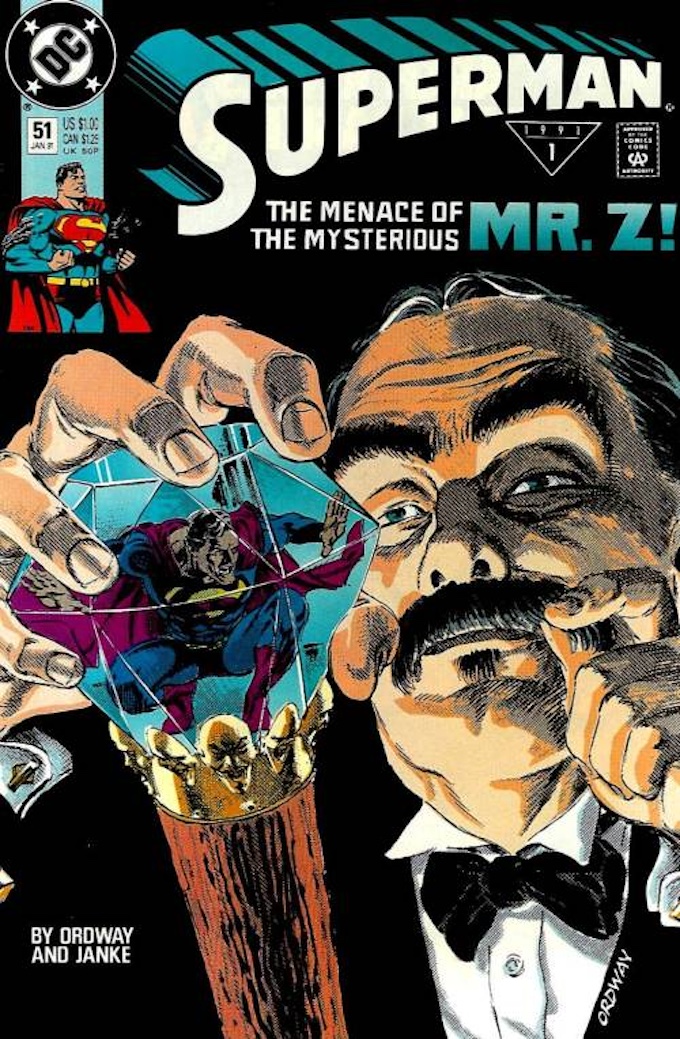
(To be fair, the comic shop as a way to distribute comics did become more common in the late seventies and early eighties, but not every town had one, so for a lot of readers the spinner rack was how they got their comics if they didn’t go through the publishers’ subscription service.)
Not every character that had multiple books followed this. During the early to mid-eighties Batman and Detective Comics served as what was essentially a twice monthly Batman comic, but this was a rarity and Batman had the advantage that the same writer, whether it was Gerry Conway or Doug Moench, worked on both titles. The same thing happened with the X-Men books, and it was such a novelty when they did that Marvel published a reading guide in their Bullpen Bulletins, the hype page that ran in just about every Marvel comic.
The road to the Triangle era began a year and change after Superman got his big revamp in 1986. After Man of Steel wrapped up with issue six there were three main Superman titles: Superman, Adventures of Superman, and Action Comics. At the beginning of this era John Byrne was writing and drawing both Superman and Action with Marv Wolfman and Jerry Ordway serving as writer and artist on Adventures. While the Superman books did cross over into each other during the Legends event and Superman and Action served as the middle part of a story that served to explain how the Legion of Super-Heroes still had Superboy as a member despite the Crisis wiping him out of the continuity, the titles mainly stuck to their own plots and arcs for that first year.
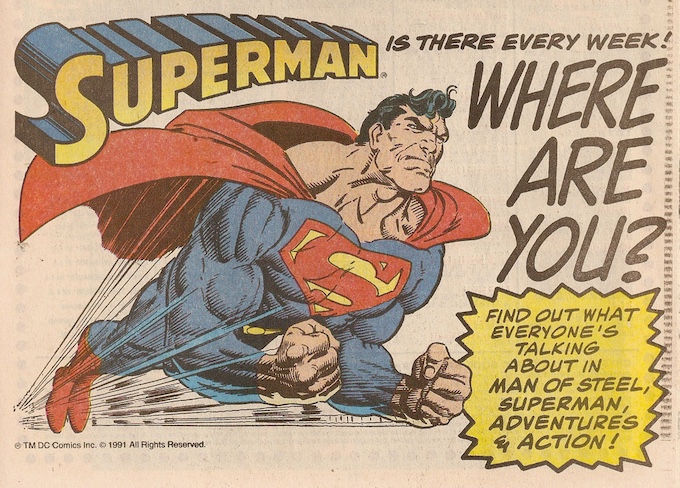
After Wolfman left Adventures with issue #435 the connection between the titles became tighter, which was easier to do now that John Byrne was writing all three of the books. Stories began starting in one title and then continuing into the others and this became more common after Action Comics became Action Comics Weekly starting with issue #601. This continued up to The Supergirl Saga, which crossed over between Superman and Adventures and also served as the last books Byrne would write before leaving the titles in June of 1988.
After Bryne’s departure, Jerry Ordway began writing and drawing Adventures of Superman and Roger Stern and Kerry Gammill took over Superman but even though you had two writers the tight connection between Superman and Adventures of Superman continued. This back and forth between the two books culminated in a storyline called Exile, which weaved through both of the Superman titles for six months and served as the first event story for the Man of Steel in the Post Crisis era.
Putting The Pieces Into Place
The editor of the Superman titles at this time was Mike Carlin. Carlin came to DC Comics after being let go from Marvel Comics in 1987 and took over editorial duties of the Superman titles from Andrew Helfer. He took inspiration for creating a connection between the Superman titles from the Spider-Man books of the mid-1980s. Amazing Spider-Man, Spectacular Spider-Man, and Web of Spider-Man all had their own creative teams and plotlines but events in one book would be referenced in the other, which tied them altogether. The Superman line took this idea a step further. Like the Spider-Man books, Superman and Adventures of Superman had A plots that were part of that particular title. Unlike the Spider-Man books, there were sub-plots and story beats that weaved through all of the titles that went beyond simply tying them together. Like the Batman books of the early to mid-eighties the Superman line was a de facto twice monthly comic and that continued post Exile when two books became three after Action Comics returned to its previous monthly status.
What this storytelling style did allowed the writers and artists to flesh out Superman’s world, both in terms of the supporting cast and in evolving Clark Kent as a character. One of these storylines that made its way through the titles was the romance between Clark Kent and Lois Lane. Lois and Clark as a couple had a rough start in the Post-Man of Steel era with romantic rivals (Cat Grant for Clark and Jose Delgado for Lois) and complications (in an effort to keep Lois from putting two and two together on Clark being Superman Jonathan Kent told Lois that Superman and Clark were raised together as brothers, which in addition to being one of the worst lies ever told made Lois feel that Clark and Superman had been playing games with her) but after Exile and a storyline called Day of the Krypton Man (where Clark’s Kryptonian side threatened to subsume his personality thanks to the alien artifact known as the Eradicator) the two began dating. Finally, in Krisis of the Krimson Kryptonite, Clark popped the question, Lois said yes, and the two were engaged.
And this was the genius of what became The Triangle Era. Storyline built upon storyline. Characters and concepts were allowed to develop organically because with three book there was plenty of real estate to build on. By the time Lois and Clark were engaged the story telling engine was built and in place and ready to keep on giving readers a near weekly Superman title to follow.
The Triangle Era Begins
The era officially began with Superman #51, which featured the introduction of a villain named Mister Z. On the cover was a small triangle with “1991/1” placed inside of it. A triangle marked “1991/2” was placed on the cover of Adventures of Superman #474 and Action Comics #661 was designated “1991/3”. For the next five months the Superman titles settled into that release pattern and took full advantage of the serialized nature of the various books. At the end of Action Comics #662 Clark revealed to Lois that he was Superman and the fallout from that revelation stretched over the next few months. During that time Superman was bounced around time in the storyline Time and Time Again, which continued the pattern of a big storyline followed by a month or two of smaller one and done stories that had started before the triangles became a going concern.
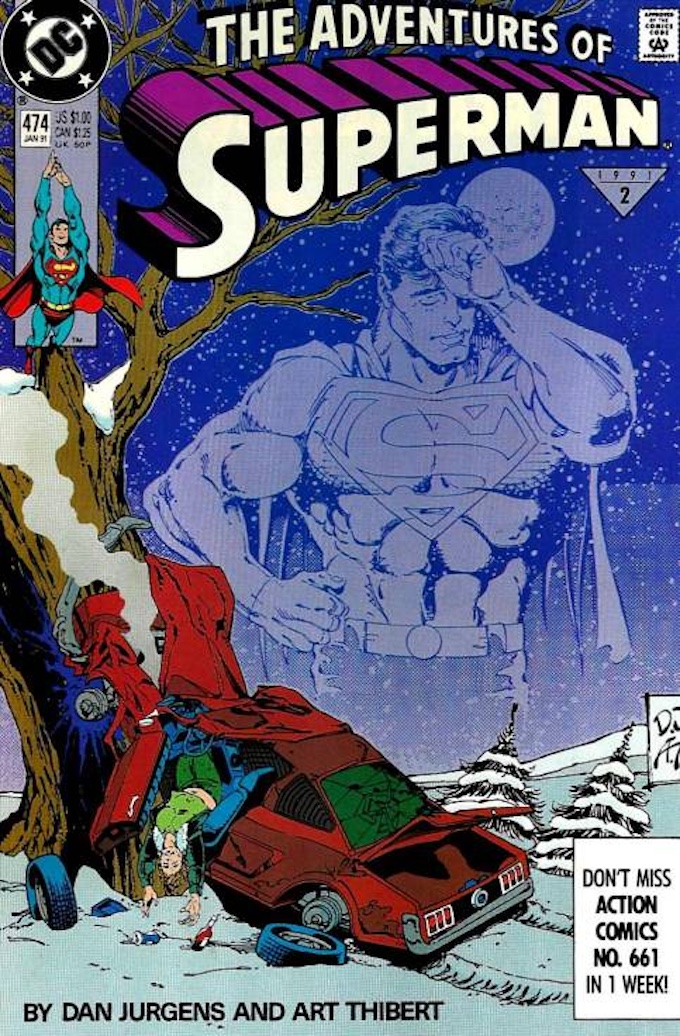
The next phase of the era kicked off in May of 1991 when Superman: The Man of Steel was added to the Superman line of books. This was significant as only one other character, Spider-Man, had four ongoing titles featuring their adventures. Even Batman only had three books at the time, though that would change in 1992 when Batman: Shadow of the Bat #1 was released. Superman: The Man of Steel changed the game slightly. Now there would be a Superman book on the stands nearly every week, except for when the month had five weeks instead of four. Writer Louise Simonson and artist Jon Bogdanove joined the creative teams which, at that time, included Dan Jurgens writing and drawing Superman, Jerry Ordway and Tom Grummett on Adventures of Superman, and Roger Stern and Jackson Guice on Action Comics. Each team had their own way of telling stories and their own side characters they liked to play with, but the characterization of all the main players was consistent.
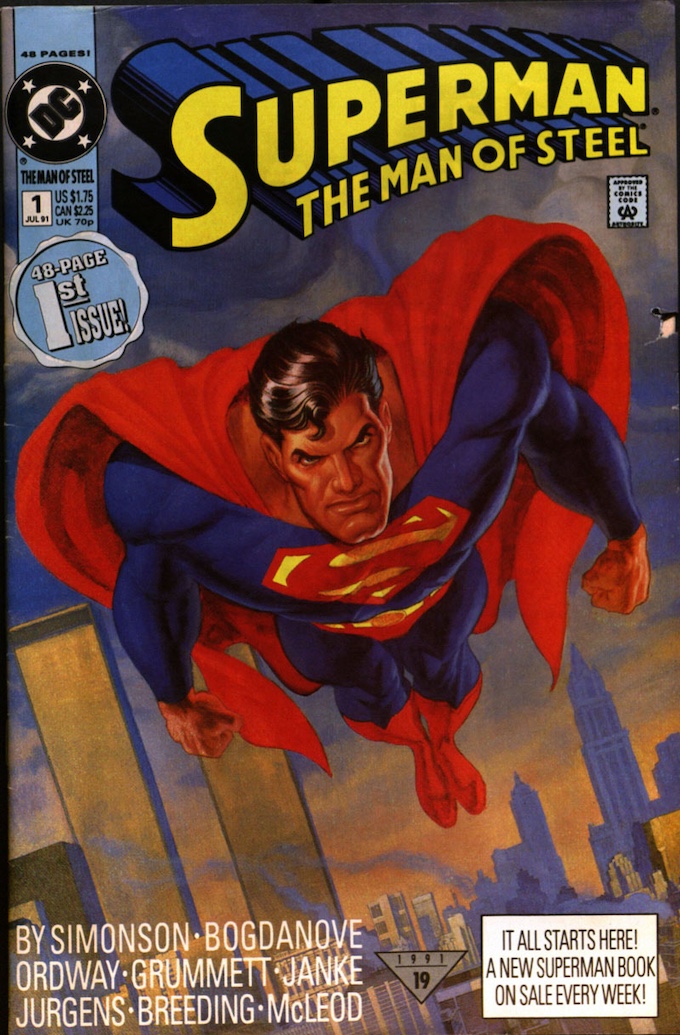
The stories themselves got bigger. Panic in the Sky ran through the books in early 1992 and featured a host of other DC heroes to help Superman deal with the imminent invasion of Brainiac and Warworld. Later in the year there was a smaller story called The Blaze/Satanus War, which found Superman caught in the middle of a family dispute between the demonic Blaze and her brother Satanus, who hid under the human guise of Collin Thornton. Both stories were the payoff to story elements established in earlier stories, which was another strength of the Triangle Era. Because of the number of books involved, the creators could either use past events as springboards for bigger stories or place story beats in the books that would seed the next event.
Summit on Mount Superman
So, how did editor Mike Carlin and the creators keep everything straight?
The Super Summit.
The Super Summit was the regular meetings Mike Carlin held with the various writers, pencillers, inkers, and even the colorist to map out the next years’ worth of stories. The summits began kind of by accident at the International Superman Exposition, which was held in Cleveland, Ohio in June of 1988. One night at dinner Carlin and the Superman creators that were in attendance broke down the Exile storyline and Carlin liked the idea so much he made it an official thing. Everyone in attendance had a voice and it became a place where ideas could be brought up, debated, shot down, brought up again later in a different way all towards the goal of telling the best stories possible. Carlin only had one rule and that was everyone had to check their egos at the door. The only person in the room that was allowed to have an ego was Superman.
In addition to these meetings Carlin would also send out packages to all the creators at the end of every week contianing photocopies of the art pages and scripts that had come in over the course of the previous week. This not only kept everyone up to date on the latest developments between the titles but it also, according to Carlin, fueled a friendly competition that brought out the best in everyone involved.
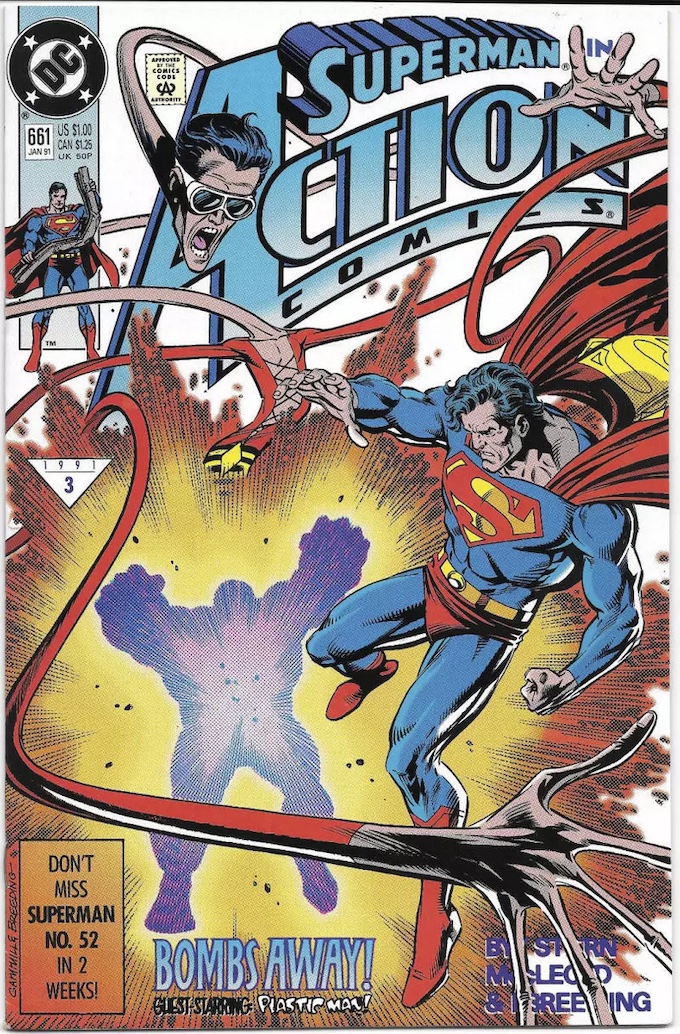
Death and Resurrections
The ultimate test for the Triangle Era came when Carlin and crew decided to kill the Man of Steel. Originally the teams had a series of stories planned that would culminate in the wedding of Lois and Clark. Things changed when what would eventually become the ABC series Lois & Clark: The New Adventures of Superman was put into production. There has been an urban legend for years that it was the executives at Warner Brothers that put the wedding on hold so that there could be wedding synergy between the comics and the television series, but it was editor Mike Carlin that decided to put a pause on the nuptials. An emergency meeting was held to come up with new story beats to replace the ones they had previously come up with and at one point Jerry Ordway offered an idea he often threw out to the room, in jest, when ideas were running thing.
“Let’s just kill him.”
From that joke came The Death and Return of Superman saga. The story lasted almost a year and stretched over the four Superman titles, two issues of Justice League America, an issue of Green Lantern, and three specials. The story could have been told without having the four titles connected by the triangles, but it was one of the aspects of that saga that made it work so well. Not only did it allow the creators to explore what Superman’s death meant to the people in his life and the world in general, it gave readers a near weekly saga that kept them coming back to the newsstand or the comic shop week after week to get the next chapter.
And it was something Superman needed. Despite garnering critical acclaim, sales on the Superman titles were not as high as other comics of the era. This was the early nineties when the X-Men and Spider-Man were the big sellers. Then, in early 1992, six of Marvel’s biggest artists formed their own imprint called Image, which released million selling titles like Youngblood, Spawn, Savage Dragon, and Wild C.A.T.s. The media hype surrounding Superman’s death not only drove outsiders to the comic shops to buy the book that would surely increase in value and allow them to put their kids through college (spoiler; it didn’t) but also made current readers who had previously ignored the character interested in checking out the Superman line.
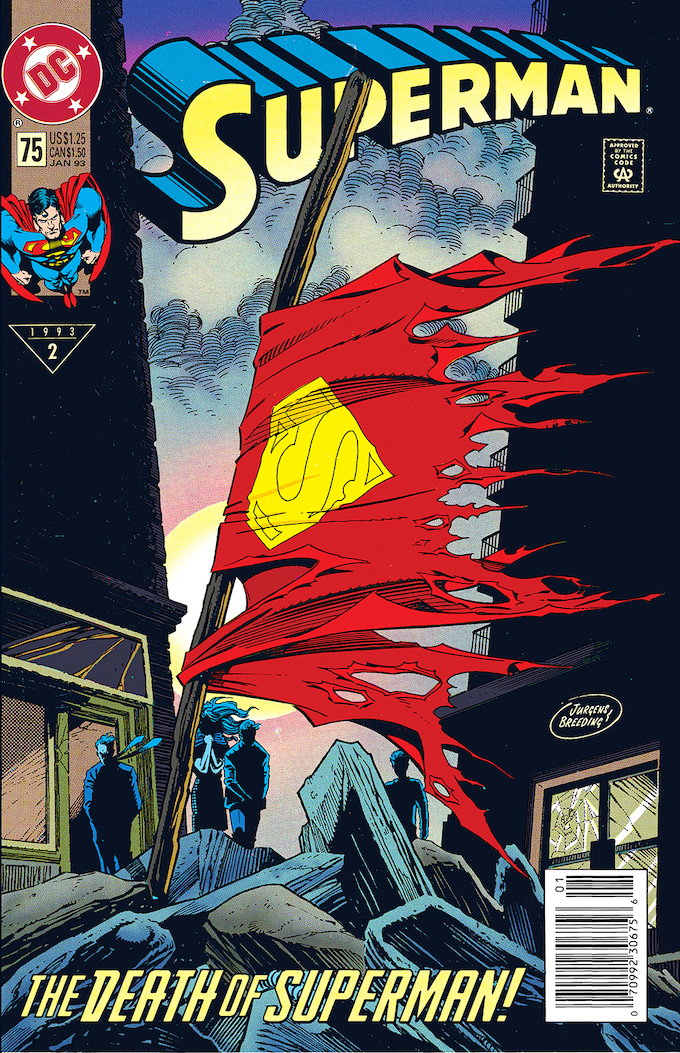
Five Makes Weekly
It was during this time that changes began to occur with the creative teams. Halfway through the Death and Return saga Jerry Ordway left the writing chores of Adventures of Superman and Karl Kesel came on board as writer. In 1994, Roger Stern left Action Comics and was eventually replaced with writer Dave Michelinie. Even with these shifts in creators the books continued the “event followed by shorter stories followed by event” cycle that had been working so well.
In May of 1995, during the waning days of Mike Carlin’s time as editor (before KC Carlson and then Joey Cavalieri stepped into that role) a fifth ongoing Superman title called Superman: The Man of Tomorrow began its short life. The difference between this and the other Superman titles was that Man of Tomorrow was a quarterly book, not a monthly. Its practical purpose was to fill the gap during the months where there were five Wednesdays instead of four. Originally the title was written by Roger Stern, returning around a year after he left Action Comics, with art by Tom Grummett, who had left Adventures of Superman shortly after Reign of the Supermen ended. The Superman titles were now a truly weekly event with a new chapter coming out 52 times a year.
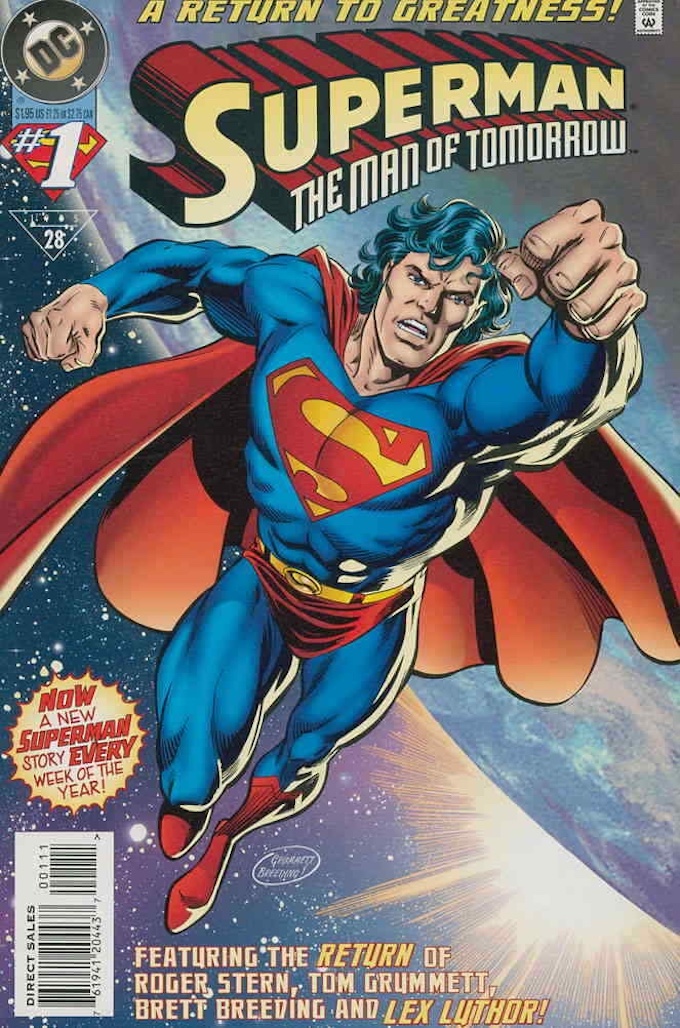
Then, in 1996, a new idea was launched. Superman: The Wedding Album came out in early October of 1996 and, as the title would suggest, featured the long-delayed wedding of Lois and Clark. The idea of a special, oversized issue typing into, starting, or ending a big storyline continued December of 1997 with Superman Red/Superman Blue #1, which took place two thirds of the way into the Electric Blue costume era, and was followed by Superman Forever #1 in April of 1998, which ended that story and returned Superman to his traditional costume and powers.
The Final Days of the Triangle Era
For the next seventeen months Man of Tomorrow and the various oversized specials (which included Save the Planet in August of 1998 and King of the World in April of 1999) kept the weekly status of the Superman titles going. Man of Tomorrow ended its run with issue fifteen in September of 1999 and became the first casualty of the era. It ended with a whimper as a tie-in to the DC event of that year called Day of Judgment. An argument could be made that with the various specials and the institution of the Fifth Week Event (where DC would put out a handful of titles around a single theme or story idea during the “skip weeks”) that Man of Tomorrow was made obsolete. Still, it was the only time where an ongoing book would be cancelled during the Triangle Era.
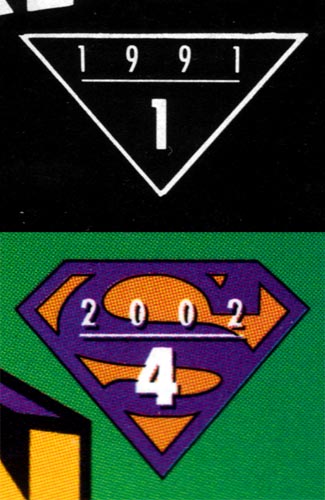
In October of 1999 Eddie Berganza became the new editor of the Superman titles and with him came new writers for the three of the four titles. Jeph Loeb on Superman, Joe Kelly on Action Comics, and Stuart Immonen and Mark Millar on Adventures of Superman, though they would be quickly replaced with J.M. DeMatteis and then, later still, Joe Casey. Writer Mark Schultz stayed on Superman: The Man of Steel, a title he began writing before the editorial change. There were still oversized specials tied to big storylines like Y2K, Emperor Joker, and President Lex, and the triangles continued to appear on the books, though they did get a bit of a facelift. In March of 2000 the triangles because S shields. There was a small bit of irony to this change happening so close to the end of the era. Mike Carlin had wanted the S shields from the beginning but there were some issues with making that happen.
One of the main reasons the era ended was that the teams that started working on the Superman titles in 1999 were not as on board with the Triangle system as the teams that were there when it started. This is understandable. That system came up organically and the writers and artist and editors that came later knew how the game was played. When Berganza began his editorial tenure, the Superman books were entering a new era and the creators that came on to those books were picked to tell a particular type of Superman story. Superman focused on the Daily Planet staff and more traditional Superman stories. Adventures was more about the people of Metropolis, Action was all about the action, and Superman: The Man of Steel explored the more science fiction elements of the character. Because the creators were focused on their end of Superman’s world there was less and less desire to tie the books together as closely as they had been.
This didn’t stop the creators from telling stories that crossed over the titles. The previously mentioned Y2K changed Metropolis to a literal city of tomorrow thanks to a Brainiac from the future. Emperor Joker was a reality bending tale that involved the Joker gaining a portion of Mister Mxyzptlk’s power. President Lex wasn’t a crossover in the traditional sense, but all of the books had to deal with the fact that Lex Luthor was elected President of the United States. Return to Krypton made it seem like the origin that had been in place since 1986 may not have been the actual origin of Superman. Then there was the big one. Our Worlds at War, which not only ran through the Superman books but other DC books and specials as well.
Finally, in November of 2001, the Triangle Era officially ended, and it went out with a mistake in the numbering. Adventures of Superman #598 was supposed to be Triangle Number 2002-2, but for some reason the number that ended up on the cover was 2002-6. This was probably not intentional, but it does suggest that the triangles were not as important to the people working on the Superman titles as they had been.
After that the triangles/shields disappeared, and while the Superman titles continued to take place in the same world, they dealt with their own storylines outside of the odd crossover here and there.
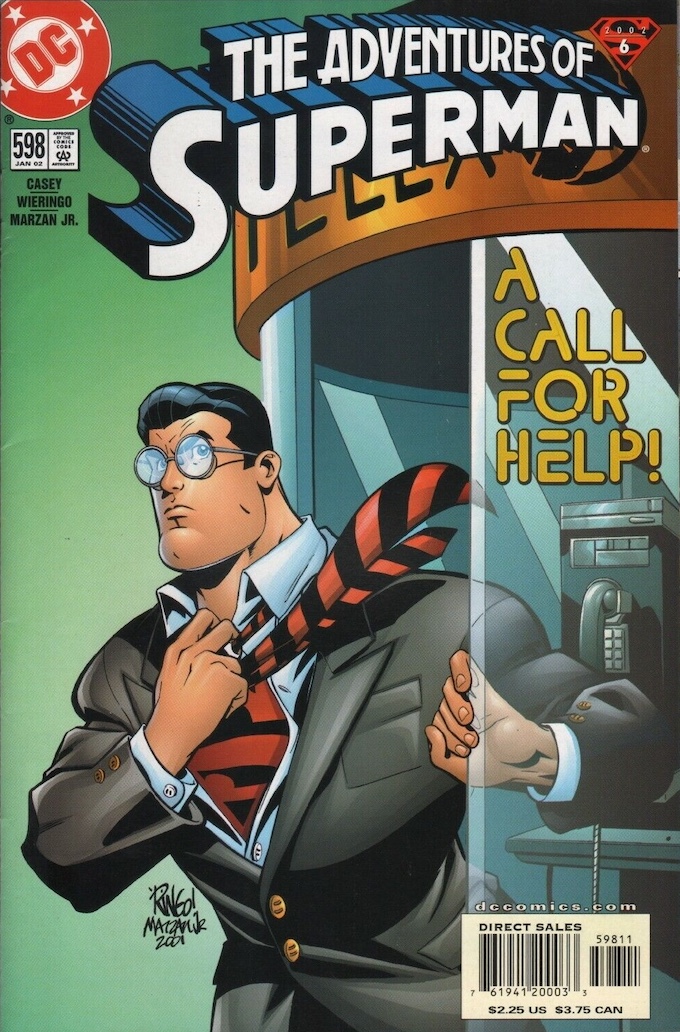
The Legacy of the Triangle Era
For eleven years the Superman titles were connected in a way that they had never been before and, arguably, since. The fact that it worked was a kind of miracle and involved several factors that came together to catch lightning in a bottle. It was the right editor assembling the right creative teams and all of that happened at just the right time for the market to support what they were attempting. When the Triangle Era began the Superman titles were $1.00 an issue and by the end, they were only $2.25. From a purely monetary level it would only cost between $4 and $9 a month to buy the entire line. Factor in the audience of the time willing to follow all those titles and you have the ingredients for a fondly remembered era.
This leads to the questions of what about that era made readers so loyal to it and why is it so fondly remembered?
At this point I can only speak for myself, but I’ve talked to enough fans of the Triangle Era to know that, for the most part, there were certain aspects that spoke to us as readers. The writers and artists were able to create a mix of super-hero action and soap opera drama that made us want to come back week after week, month after month, year after year. It wasn’t just about seeing who the villain of the month was. It was about Clark and Superman, but it was also about Lois and Jimmy Olsen and Perry White and Cat Grant and Ron Troupe and Jose Delgado and Bibbo and Jonathan Kent and Martha Kent and Lana Lang and Pete Ross, and Allie the office girl, and Whit, and even later supporting characters like Ashbury Armstrong, Dirk Armstrong, and Scorn.
To quote a good friend when we talk about why he loves classic Spider-Man comics, we came for Superman, but we stayed for Clark and everyone else.
Big super-hero action will only get you so far. To develop an audience, you have to make the readers care about the characters they are reading about. Jerry Ordway, Roger Stern, Dan Jurgens, Louise Simonson, Jon Bogdanove, Karl Kesel, and David Michelinie, all under the editorial leadership of Mike Carlin, gave us those characters to care and compelling stories that kept us on the edge of our seats.
Did every storyline work? No, but no one bats a thousand. Some stories and ideas worked better than others and towards the end of the 1990s the books were full of so many side characters that Superman seemed to sometime get lost in his own books.Nothing lasts forever, but for a time the Superman titles were a place where you could come and find a world to get lost in and characters that you could love.
Like Bibbo. Everyone loves Bibbo.
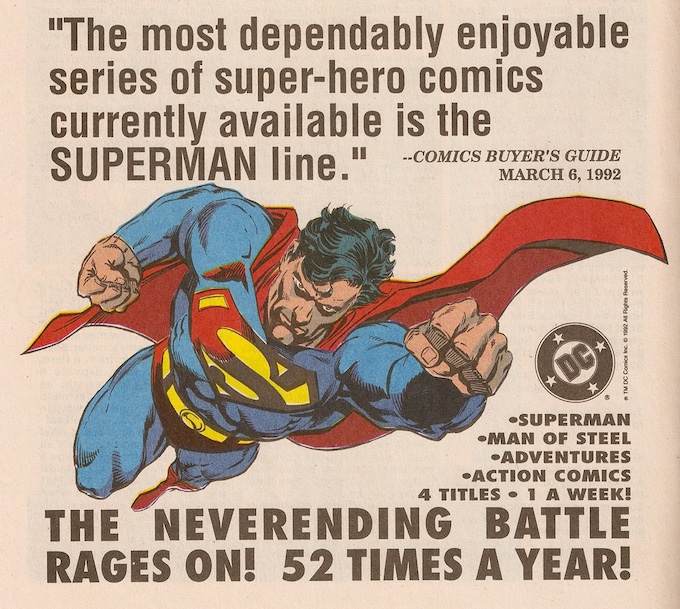
Did the Triangle system work for everyone? No. There were readers at the time that didn’t want to have to read the titles they weren’t interested in and that’s fair. I never argue taste. But for me, and a lot of other Superman fans, it was the best of times.
DC tried to bring back a little bit of that magic during the New Krypton storyline that ran from 2008 to 2010. S shields with numbers in them let you know where a particular issue fit into the saga and while it was kind of cool it just wasn’t the same. It ended up feeling hollow, like the powers that be at the time were trying to trade in something they hadn’t earned. You can’t just make something “a thing” again just by saying it’s “a thing” and that leads to the reason the Triangle Era worked so well.
It. Just. Happened.
No one set out to make it happen. Carlin and crew took a chance with tying two titles together and, when it worked, kept upping the ante and refining the process. And it was particular to Superman. Other characters had multiple titles, but for the most part unless those titles did a crossover, they had little to do with each other and there’s nothing wrong with that. We were just lucky enough that it happened with Superman.
There have been great Superman stories told since the Triangle Era ended and there are great stories that have yet to be told, but that era and those creators and that editor will always be remembered for crafting one of the most consistent storytelling eras the character has ever had.
But that could just be me.
I’m biased.
Now go take that ibuprofen. You’ll regret it in an hour if you don’t.


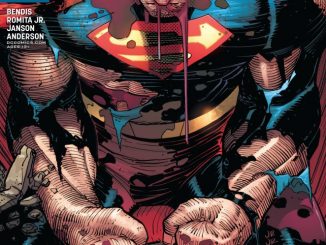
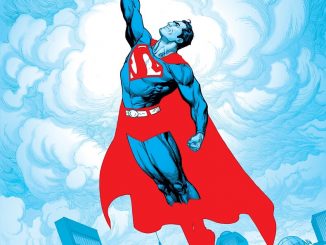
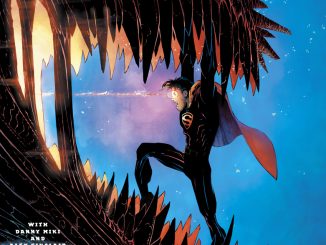
Fantastic article, thank you.
That triangle era Omnibus announcement and this article has got me all nostalgic about buying weekly Superman comics in the 90’s. It’s a must buy for me!
It definitely gave off a weekly vibe with the integrated triangle system. It was the reason why Superman was high on my pull list back then.